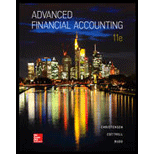
Concept explainers
a.
To prepare:
Introduction: An asset is a resource owned by business either tangible or intangible form to produce economic value. It provides the future benefits to the business. It is used to increase the value of firm by providing benefits.
a.
Explanation of Solution
In the books of Company F:
Record transfer of assets and liabilities:
| Date | Account | Debit ($) | Credit($) |
| Investment in Company K common stock | 66,000 | ||
| 28,000 | |||
| Accounts Payable | 22,000 | ||
| Cash | 15,000 | ||
| | 24,000 | ||
| Inventory | 9,000 | ||
| Land | 3,000 | ||
| Depreciable Assets | 65,000 | ||
| (To record formation of subsidiary.) |
Table (1)
- Investment in Company K common stock is an asset and it is increased by $66,000. Therefore, Investment in Company K common stock account is debited with $66,000.
- Accumulated depreciation is a contra asset and it is decreased by $40,000. Therefore, Accumulated depreciation account is debited with $40,000.
- Accounts Payable is a liability and it is decreased by $22,000. Therefore, Accounts Payable account is debited with $22,000.
- Cash is an asset and it is decreased by $15,000. Therefore, cash account is credited with $15,000.
- Accounts Receivable is an asset and it is decreased by $24,000. Therefore, Accounts Receivable account is credited with $24,000.
- Inventory is an asset and it is decreased by $9,000. Therefore, Inventory account is credited with $9,000.
- Land is an asset and it is decreased by $3,000. Therefore, Land account is credited with $3,000.
- Depreciable Asset is an asset and it is decreased by $65,000. Therefore, Depreciable Asset account is credited with $60,000.
b.
To prepare: Journal entries that subsidiary company would record.
Introduction: An asset is a resource owned by business either tangible or intangible form to produce economic value. It provides the future benefits to the business. It is used to increase the value of firm by providing benefits.
b.
Explanation of Solution
In the books of subsidiary company:
Record transfer of assets and liabilities:
| Date | Account | Debit ($) | Credit($) |
| Cash | 15,000 | ||
| Accounts Receivable | 24,000 | ||
| Inventory | 9,000 | ||
| Land | 3,000 | ||
| 65,000 | |||
| Accumulated depreciation | 28,000 | ||
| Accounts Payable | 22,000 | ||
| Common Stock | 48,000 | ||
| Additional paid in capital | 18,000 | ||
| (To record receipt of assets and liabilities and issuance of stock.) |
Table (2)
- Cash is an asset and it is increased by $15,000. Therefore, cash account is debited with $15,000.
- Accounts Receivable is an asset and it is increased by $24,000. Therefore, Accounts Receivable account is debited with $24,000.
- Inventory is an asset and it is increased by $9,000. Therefore, Inventory account is debited with $9,000.
- Land is an asset and it is increased by $3,000. Therefore, Land account is debited with $3,000.
- Depreciable Assets is an asset and it is increased by $65,000. Therefore, Depreciable Assets account is debited with $65,000.
- Accumulated depreciation is a contra asset and it is increased by $28,000. Therefore, Accumulated depreciation account is credited with $28,000.
- Accounts Payable is a contra asset and it is increased by $22,000. Therefore, Accounts Payable account is credited with $22,000.
- Common Stock is equity and it is increased by $48,000. Therefore, Common Stock account is credited with $48,000.
- Additional paid in capital is equity and it is increased by $18,000. Therefore, Additional paid in capital account is credited with $18,000.
Want to see more full solutions like this?
Chapter 1 Solutions
Advanced Financial Accounting
- What is the net operating income ?arrow_forwardLast year, Wax Republic collected total tax revenues of $2.4 billion and spent $3.1 billion on various public services. The country currently owes $8.2 billion to investors who hold its bonds and other debt obligations. What was the country's deficit for the year? a) $0.7 billion b) $8.2 billion c) $5.1 billion d) $10.6 billion e) None of the abovearrow_forwardCan you help me solve this financial accounting question using valid financial accounting techniques?arrow_forward
 Financial AccountingAccountingISBN:9781337272124Author:Carl Warren, James M. Reeve, Jonathan DuchacPublisher:Cengage Learning
Financial AccountingAccountingISBN:9781337272124Author:Carl Warren, James M. Reeve, Jonathan DuchacPublisher:Cengage Learning

